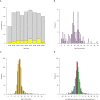Current drivers and geographic patterns of HIV in Lesotho: implications for treatment and prevention in Sub-Saharan Africa
- PMID: 24131484
- PMCID: PMC4016528
- DOI: 10.1186/1741-7015-11-224
Current drivers and geographic patterns of HIV in Lesotho: implications for treatment and prevention in Sub-Saharan Africa
Abstract
Background: The most severe HIV epidemics worldwide occur in Lesotho, Botswana and Swaziland. Here we focus on the Lesotho epidemic, which has received little attention. We determined the within-country heterogeneity in the severity of the epidemic, and identified the risk factors for HIV infection. We also determined whether circumcised men in Lesotho have had a decreased risk of HIV infection in comparison with uncircumcised men. We discuss the implications of our results for expanding treatment (current coverage is only 60%) and reducing transmission.
Methods: We used data from the 2009 Lesotho Demographic and Health Survey, a nationally representative survey of 3,849 women and 3,075 men in 9,391 households. We performed multivariate analysis to identify factors associated with HIV infection in the sexually active population and calculated age-adjusted odds ratios (aORs). We constructed cartographic country-level prevalence maps using geo-referenced data.
Results: HIV is hyperendemic in the general population. The average prevalence is 27% in women and 18% in men, but shows substantial geographic variation. Throughout the country prevalence is higher in urban centers (31% in women; 21% in men) than in rural areas (25% in women; 17% in men), but the vast majority of HIV-infected individuals live in rural areas. Notably, prevalence is extremely high in women (18%) and men (12%) with only one lifetime sex partner. Women with more partners have a greater risk of infection: aOR 2.3 (2 to 4 partners), aOR 4.4 (≥5 partners). A less substantial effect was found for men: aOR 1.4 (3 to 6 partners), aOR 1.8 (≥7 partner). Medical circumcision protected against infection (aOR 0.5), traditional circumcision did not (aOR 0.9). Less than 5% of men in Lesotho have been medically circumcised; approximately 50% have been circumcised using traditional methods.
Conclusions: There is a substantial need for treatment throughout Lesotho, particularly in rural areas where there is the greatest burden of disease. Interventions aimed at reducing the number of sex partners may only have a limited effect on reducing transmission. Substantially increasing levels of medical circumcision could be very effective in reducing transmission, but will be very difficult to achieve given the current high prevalence of traditional circumcision.
Figures




Similar articles
-
Correlates of HIV infection in adolescent girls and young women in Lesotho: results from a population-based survey.Lancet HIV. 2019 Sep;6(9):e613-e622. doi: 10.1016/S2352-3018(19)30183-3. Epub 2019 Aug 14. Lancet HIV. 2019. PMID: 31422056 Free PMC article.
-
Characteristics of men who have sex with men in southern Africa who seek sex online: a cross-sectional study.J Med Internet Res. 2015 May 25;17(5):e129. doi: 10.2196/jmir.4230. J Med Internet Res. 2015. PMID: 26006788 Free PMC article.
-
Medically, Traditionally, and Dually Circumcised Men in Lesotho: Population-Based Measurements of HIV/STI Infections, Sexual Risk Behaviors, and Service Use Patterns.AIDS Behav. 2020 Jul;24(7):2112-2118. doi: 10.1007/s10461-019-02776-2. AIDS Behav. 2020. PMID: 31927757
-
AIDS in sub-Saharan Africa: the epidemiology of heterosexual transmission and the prospects for prevention.Epidemiology. 1993 Jan;4(1):63-72. Epidemiology. 1993. PMID: 8420583 Review.
-
AIDS in rural Africa: a paradigm for HIV-1 prevention.Int J STD AIDS. 1996 Jul;7(4):236-43. doi: 10.1258/0956462961917906. Int J STD AIDS. 1996. PMID: 8876353 Review.
Cited by
-
Correlates of HIV infection in adolescent girls and young women in Lesotho: results from a population-based survey.Lancet HIV. 2019 Sep;6(9):e613-e622. doi: 10.1016/S2352-3018(19)30183-3. Epub 2019 Aug 14. Lancet HIV. 2019. PMID: 31422056 Free PMC article.
-
Notes from the Field: HIV Testing in Health Care Facilities - Lesotho, 2017.MMWR Morb Mortal Wkly Rep. 2018 Jul 6;67(26):748-749. doi: 10.15585/mmwr.mm6726a5. MMWR Morb Mortal Wkly Rep. 2018. PMID: 29975675 Free PMC article. No abstract available.
-
Incidence of cardiometabolic diseases in a Lesotho HIV cohort: Evidence for policy decision-making.South Afr J HIV Med. 2021 Jun 28;22(1):1246. doi: 10.4102/sajhivmed.v22i1.1246. eCollection 2021. South Afr J HIV Med. 2021. PMID: 34230861 Free PMC article.
-
Sex-specific maps of HIV epidemics in sub-Saharan Africa.Lancet Infect Dis. 2016 Dec;16(12):1320-1322. doi: 10.1016/S1473-3099(16)30451-0. Epub 2016 Nov 15. Lancet Infect Dis. 2016. PMID: 27998582 Free PMC article. No abstract available.
-
Brief report: Mobility and circular migration in Lesotho: implications for transmission, treatment, and control of a severe HIV epidemic.J Acquir Immune Defic Syndr. 2015 Apr 15;68(5):604-8. doi: 10.1097/QAI.0000000000000526. J Acquir Immune Defic Syndr. 2015. PMID: 25763787 Free PMC article.
References
-
- Measure Demographic and Health Surveys. Calverton, MD: Measure DHS. ICF Macro; 2012. [ http://www.measuredhs.com]
-
- Bernasconi D, Tavoschi L, Regine V, Raimondo M, Gama D, Sulgencio L, Almaviva M, Galli C, Ensoli B, Suligoi B, Sukati H, Buttò S. Identification of recent HIV infections and of factors associated with virus acquisition among pregnant women in 2004 and 2006 in Swaziland. J Clin Virol. 2010;11:180–183. doi: 10.1016/j.jcv.2010.04.010. - DOI - PubMed
-
- Shannon K, Leiter K, Phaladze N, Hlanze Z, Tsai AC, Heisler M, Iacopino V, Weiser SD. Gender inequity norms are associated with increased male-perpetrated rape and sexual risks for HIV infection in Botswana and Swaziland. PLoS One. 2012;11:e28739. doi: 10.1371/journal.pone.0028739. - DOI - PMC - PubMed
-
- UNAIDS. Swaziland: HIV Prevention Response and Modes of Transmission Analysis. 2009. [ http://siteresources.worldbank.org/INTHIVAIDS/Resources/375798-110303715...]
Publication types
MeSH terms
Grants and funding
LinkOut - more resources
Full Text Sources
Other Literature Sources
Medical

